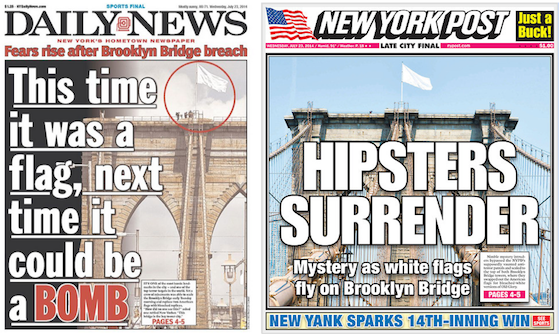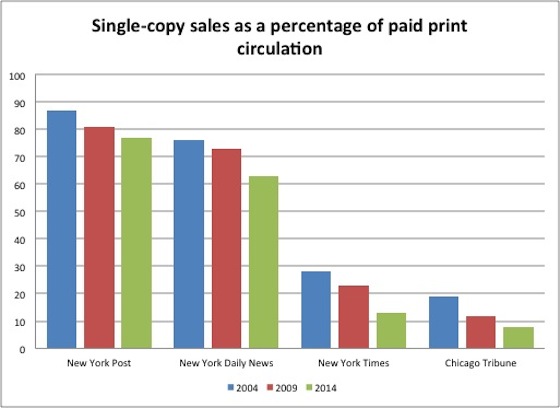Pranksters’ mysterious swap of American flags for white banners on the Brooklyn Bridge last week seemed made for tabloid glory. With most details of the incident still unclear, the New York Post and Daily News had plenty of room to maneuver. And they didn’t disappoint. “HIPSTERS SURRENDER,” the Post’s cover blared from newsstands the next morning. “This time it was a flag, next time it could be a BOMB,” the Daily News warned.

Still got it
The New York tabloids certainly haven’t lost their penchant for melodrama, with loud headlines attracting hundreds of thousands of single-copy buyers daily. But the continued page-one bravado belies nose-diving newsstand sales, fierce competition online, and a potential struggle between the publications’ local journalism roots and viral journalism ambitions.
It’s a familiar quandary for media outlets with declining newspaper sales: whether to continue the local reporting that was the historical backbone of print products, or to follow sexier stories that might blow up on Twitter and attract millions worldwide. Of course, the Post and Daily News have always offered readers both budget reports and fare of the “headless body in topless bar” variety. But with so many news sites today vying for one online audience, the war for eyeballs has taken tabloid-style news mainstream.
“In some sense, everyone is stealing the tabloids’ readership,” said Daniel Hallin, a communications professor at University of California, San Diego. “The kind of content they used to specialize in has become much more generalized today.”
Tabloids are still struggling to calibrate their newsrooms for this more crowded, digitally focused market. The Post, which some analysts estimate hemorrhages tens of millions of dollars annually, announced plans last year to cut its newsroom staff by 10 percent. Its print circulation, meanwhile, has fallen from about 600,000 to 250,000 over the past decade, according to the Alliance for Audited Media.
The Daily News has similarly seen print readership dwindle during that span, from roughly 700,000 to 300,000. As first reported by Capital New York, the paper laid off at least 17 journalists earlier this month, most of them print hands or photographers. CEO Bill Holiber and Editor Colin Myler said in an email to employees that the “strategic changes” will help the paper reach its goal of attracting “more readers to the Daily News and grow our digital audience both locally and nationally.” The move comes after more than a dozen newsroom jobs were slashed in both 2011 and 2013.
Representatives for both papers did not respond to requests for comment.
The digital transition has been especially bloody at the tabloids due to a historical reliance on single-copy sales—rather than subscriptions—for print revenue. Newsstands are an especially cheap way to distribute papers, and well suited to areas where commuters take trains to work. But while a newspaper subscription is conceptually similar to an online paywall—and The New York Times has proven that they can work, at least for The New York Times—single-issue sales require repeated, discretionary purchases by readers. And that doesn’t play on the Web.

End of an era Source: Alliance for Audited Media
Single-copy sales have dropped off precipitously overall, both because of the financial downturn and the availability of free content on mobile devices or in subway newspapers like Metro, said Ava Seave, a consultant at Quantum Media and adjunct professor at the Columbia Business School. “If you’re a tabloid, you have competition coming and going,” she added. “It’s incredibly difficult to find a place to dominate.”
And it’s just as difficult online. The Daily News attracted 38 million unique American visitors in December—24 million of them on mobile devices —according to comScore data cited by Capital New York. The Post, meanwhile, drew more than 14 million that month, half from mobile.
While those numbers are nothing to scoff at—the Daily News ranks near the top of American newspaper sites along with The New York Times—tabloid descendants such as Mail Online, BuzzFeed, Gawker, and The Huffington Post have attracted monthly global audiences approaching or eclipsing 100 million unique visitors.
“Internet business models clearly overvalue global and national [news] and undervalue local, because it’s all about scale,” said Ken Doctor, a veteran media analyst. “If you have a business that’s global or national, you have been in a much better position. You can draw from a huge audience. Locally, then, in New York, you have a sizeable metro population but only a tiny portion of a global audience.”
Not only do Web-native outlets often target broader readerships, but they also rarely have print editions and, therefore, boast slimmer newsrooms and lower expenses. And the BuzzFeeds of the world often cover the internet—a virtual place in and of itself—as opposed to a geographic location. Scouring the Web for viral stories is much cheaper than chasing celebrities and officials through the five boroughs.
While a digitally nimble, globally focused newsroom might appear better suited to the internet, Doctor added that this shift also provides an opening for “local” papers such as the Daily News and Post. Their “opportunity here is to go much deeper in a local market with both reader and advertiser relationships,” he said. It’s unclear, however, if either are able or even willing to continue investing in such a narrow focus, not to mention whether they can turn a digital profit on it.
For now, the Post and Daily News continue to put out newspapers with their traditionally irresistible headlines, even as the number of print diehards continues to shrink. Today’s newsstand doesn’t sit along a street or inside a corner store, as audiences scan juicy headlines on Twitter or Facebook before choosing what to read.
The game of tabloid journalism is essentially the same—readers want heroes, villains, and opinions just as they always have. It’s the ground rules that have changed, Hallin said, adding, “The internet takes the newsstand sales phenomenon and applies it to each story in every moment.”
David Uberti is a writer in New York. He was previously a media reporter for Gizmodo Media Group and a staff writer for CJR. Follow him on Twitter @DavidUberti.
